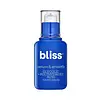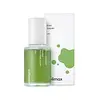What's inside
What's inside
 Key Ingredients
Key Ingredients

 Benefits
Benefits

 Concerns
Concerns

 Ingredients Side-by-side
Ingredients Side-by-side

Water
Skin ConditioningGlycolic Acid
BufferingAloe Barbadensis Leaf Juice
Skin ConditioningGlycerin
HumectantPropanediol
SolventSodium Hydroxide
BufferingPolyacrylate Crosspolymer-6
Emulsion StabilisingGluconolactone
Skin ConditioningSaccharum Officinarum Extract
MoisturisingDipropylene Glycol
HumectantTocopherol
AntioxidantPyrus Malus Fruit Extract
Skin ConditioningCitrus Aurantium Dulcis Fruit Extract
MaskingCitrus Limon Fruit Extract
MaskingCamellia Sinensis Leaf Extract
AntimicrobialGlycyrrhiza Glabra Root Extract
BleachingSqualane
EmollientSalix Nigra Bark Extract
Skin ProtectingNymphaea Alba Flower Extract
Skin ConditioningHelianthus Annuus Seed Oil
EmollientAvena Sativa Kernel Oil
Skin ConditioningSodium Palmitoyl Proline
Skin ConditioningXanthan Gum
EmulsifyingAcacia Senegal Gum
MaskingHydroxyethyl Acrylate/Sodium Acryloyldimethyl Taurate Copolymer
Emulsion StabilisingPolyglyceryl-4 Laurate/Succinate
Lauryl Glucoside
CleansingDimethicone
EmollientSodium Citrate
BufferingPhenoxyethanol
PreservativePotassium Sorbate
PreservativeSodium Benzoate
MaskingCitric Acid
BufferingParfum
MaskingWater, Glycolic Acid, Aloe Barbadensis Leaf Juice, Glycerin, Propanediol, Sodium Hydroxide, Polyacrylate Crosspolymer-6, Gluconolactone, Saccharum Officinarum Extract, Dipropylene Glycol, Tocopherol, Pyrus Malus Fruit Extract, Citrus Aurantium Dulcis Fruit Extract, Citrus Limon Fruit Extract, Camellia Sinensis Leaf Extract, Glycyrrhiza Glabra Root Extract, Squalane, Salix Nigra Bark Extract, Nymphaea Alba Flower Extract, Helianthus Annuus Seed Oil, Avena Sativa Kernel Oil, Sodium Palmitoyl Proline, Xanthan Gum, Acacia Senegal Gum, Hydroxyethyl Acrylate/Sodium Acryloyldimethyl Taurate Copolymer, Polyglyceryl-4 Laurate/Succinate, Lauryl Glucoside, Dimethicone, Sodium Citrate, Phenoxyethanol, Potassium Sorbate, Sodium Benzoate, Citric Acid, Parfum
Morinda Citrifolia Fruit Extract 71.77%
Skin ConditioningButylene Glycol
HumectantPropanediol
SolventGlycerin
Humectant1,2-Hexanediol
Skin ConditioningDiethoxyethyl Succinate
SolventGlyceryl Acrylate/Acrylic Acid Copolymer
HumectantMorinda Citrifolia Seed Oil
Skin ConditioningCeramide NP
Skin ConditioningOlea Europaea Fruit Oil
MaskingButyrospermum Parkii Butter
Skin ConditioningSqualane
EmollientRosmarinus Officinalis Leaf Oil
MaskingMelia Azadirachta Leaf Extract
Skin ConditioningMelia Azadirachta Flower Extract
Skin ConditioningTheobroma Cacao Extract
Skin ConditioningDextrin
AbsorbentPhytosphingosine
Skin ConditioningCholesterol
EmollientSodium Hyaluronate
HumectantHydrogenated Lecithin
EmulsifyingC12-13 Pareth-9
EmulsifyingSodium Polyacryloyldimethyl Taurate
Emulsion StabilisingCaprylic/Capric Triglyceride
MaskingWater
Skin ConditioningAllantoin
Skin ConditioningAdenosine
Skin ConditioningDisodium EDTA
Chlorphenesin
AntimicrobialMorinda Citrifolia Fruit Extract 71.77%, Butylene Glycol, Propanediol, Glycerin, 1,2-Hexanediol, Diethoxyethyl Succinate, Glyceryl Acrylate/Acrylic Acid Copolymer, Morinda Citrifolia Seed Oil, Ceramide NP, Olea Europaea Fruit Oil, Butyrospermum Parkii Butter, Squalane, Rosmarinus Officinalis Leaf Oil, Melia Azadirachta Leaf Extract, Melia Azadirachta Flower Extract, Theobroma Cacao Extract, Dextrin, Phytosphingosine, Cholesterol, Sodium Hyaluronate, Hydrogenated Lecithin, C12-13 Pareth-9, Sodium Polyacryloyldimethyl Taurate, Caprylic/Capric Triglyceride, Water, Allantoin, Adenosine, Disodium EDTA, Chlorphenesin
Ingredients Explained
These ingredients are found in both products.
Ingredients higher up in an ingredient list are typically present in a larger amount.
Glycerin is already naturally found in your skin. It helps moisturize and protect your skin.
A study from 2016 found glycerin to be more effective as a humectant than AHAs and hyaluronic acid.
As a humectant, it helps the skin stay hydrated by pulling moisture to your skin. The low molecular weight of glycerin allows it to pull moisture into the deeper layers of your skin.
Hydrated skin improves your skin barrier; Your skin barrier helps protect against irritants and bacteria.
Glycerin has also been found to have antimicrobial and antiviral properties. Due to these properties, glycerin is often used in wound and burn treatments.
In cosmetics, glycerin is usually derived from plants such as soybean or palm. However, it can also be sourced from animals, such as tallow or animal fat.
This ingredient is organic, colorless, odorless, and non-toxic.
Glycerin is the name for this ingredient in American English. British English uses Glycerol/Glycerine.
Learn more about GlycerinPropanediol is an all-star ingredient. It softens, hydrates, and smooths the skin.
It’s often used to:
Propanediol is not likely to cause sensitivity and considered safe to use. It is derived from corn or petroleum with a clear color and no scent.
Learn more about PropanediolSqualane is an emollient that helps the skin hold onto moisture. It's an oily liquid that occurs naturally in certain types of fish and plant oils.
Because squalane boosts hydration in the skin, it also comes with plenty of benefits: it is an antioxidant and can help fight free radicals and skin damage. Squalane is also found to have a detoxifying effect when applied.
Squalane comes from squalene, which occurs naturally within the sebum of our skin. It is one of the oils our skin produces to keep itself hydrated. Squalane is the hydrogenated version of squalene and has a longer shelf life.
Research shows that squalane is non-irritating (even at 100% concentration).
In general, it's a fantastic ingredient. It does a great job at hydrating the skin, and it's suitable for those with sensitive skin.
The source of squalane may impact malassezia / fungal acne. This is because olive oil derived squalane can contain impurities such as fatty acids and plant waxes. Sugarcane derived squalane is recommended for anyone with malassezia concerns.
Is squalane vegan?
This depends on the source. Squalane can be derived from both plants and animals. Most squalane used in skincare comes from plants.
Please note: the source of squalane is only known if disclosed by the brand. We recommend reaching out to the brand if you have any questions about their squalane.
Read more about squalene with an "e".
Is squalane an oil?
Squalane is often called an oil, but it’s technically not; it’s a hydrocarbon, meaning it’s only made of carbon and hydrogen, unlike true oils which are triglycerides made of fatty acids and glycerol.
The term “oil-free” isn’t regulated, so companies can define it however they want. Some exclude all oils, while others just avoid mineral oil or comedogenic oils.
While some people avoid oils thinking they cause breakouts, the right kind of oil (or oil-like ingredient like squalane) can actually help balance and hydrate your skin. It’s worth testing out simple oils or squalane to see what works best for your skin.
Learn more about SqualaneWater. It's the most common cosmetic ingredient of all. You'll usually see it at the top of ingredient lists, meaning that it makes up the largest part of the product.
So why is it so popular? Water most often acts as a solvent - this means that it helps dissolve other ingredients into the formulation.
You'll also recognize water as that liquid we all need to stay alive. If you see this, drink a glass of water. Stay hydrated!
Learn more about Water